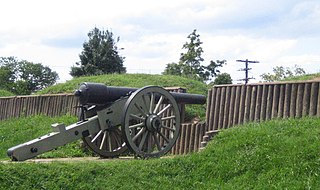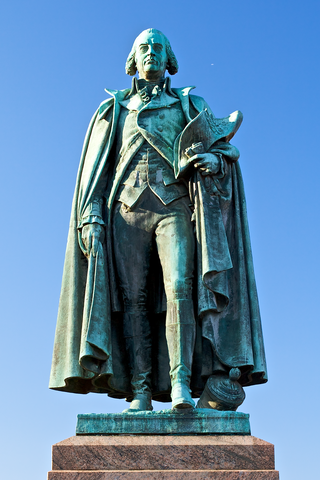
Fort Sumter is a sea fort built on an artificial island near Charleston, South Carolina to defend the region from a naval invasion. It was built after British forces captured and occupied Washington during the War of 1812 via a naval attack. The fort was still incomplete in 1861 when the Battle of Fort Sumter occurred from April 12 to 13, sparking the American Civil War. It was severely damaged during the battle and left in ruins. Although there were some efforts at reconstruction after the war, the fort as conceived was never completed. Since the middle of the 20th century, Fort Sumter has been open to the public as part of the Fort Sumter and Fort Moultrie National Historical Park, operated by the National Park Service.

Logan Circle is a historic roundabout park and neighborhood of Washington, D.C., located in Northwest D.C. The majority of Logan Circle is primarily residential, except for the highly-commercialized 14th Street corridor that passes through the western part of the neighborhood. In the 21st century, Logan Circle has been the focus of urban redevelopment and become one of Washington's most expensive neighborhoods. Today, Logan Circle is also one of D.C.'s most prominent gay neighborhoods.

The Lewis and Clark National Historical Park, located in the vicinity of the mouth of the Columbia River, commemorates the Lewis and Clark Expedition. Administration of the park, which includes both federal and state lands, is a cooperative effort of the National Park Service and the states of Oregon and Washington. The National Historical Park was dedicated on November 12, 2004.

Battleground National Cemetery is a military burial ground, located along Georgia Avenue near Fort Stevens, in Washington, D.C.'s Brightwood neighborhood. The cemetery is managed by the National Park Service, together with other components of Rock Creek Park.

Brightwood is a neighborhood in the northwestern quadrant of Washington, D.C. Brightwood is part of Ward 4.

Fort Stevens, formerly named Fort Massachusetts, was part of the extensive fortifications built around Washington, D.C., during the American Civil War.

The TitanicMemorial is a granite statue in Southwest Waterfront neighborhood of Washington, D.C., that honors the men who gave their lives so that women and children might be saved during the sinking of the Titanic. Ten days after the sinking on April 25, 1912, a group of women formed a committee to raise money for a memorial to honor the sacrifice, with a limit of $1 per person. After sending thousands of cards to other women throughout the U.S., the funds the committee had raised alongside funding from the federal government was enough to complete the project. A competition was announced for a memorial design and several were submitted. The winning design by Gertrude Vanderbilt Whitney, who later opened the Whitney Museum of American Art, became her first major commission.

The Chamberlin is a retirement community in Hampton, Virginia, overlooking Hampton Roads at Old Point Comfort. It was formerly known as the Chamberlin Hotel, named for the famed restaurateur and original owner John Chamberlin. The nine-story building sits on historic Fort Monroe and overlooks Fort Wool. Listed on the National Register of Historic Places, it has been renovated from its former life as a hotel into a luxury retirement community for people aged 55 and up.

Woodland is a small residential and industrial neighborhood in Southeast Washington, D.C. Woodland lies in Washington's Ward 8, among the poorest and least developed of the city's wards. Like the neighborhoods around it, Woodland is almost exclusively African American. Woodland is bounded by Ainger Place SE to the north; Alabama Avenue SE and Knox Place SE to the east; Hartford Street SE to the south; and Langston Place SE, Raynolds Place SE, and Erie Street SE to the southwest. Fort Stanton Park forms the northwest and northern border of the neighborhood.
Fort Stevens Ridge is a neighborhood in Northwest Washington, D.C. built during the 1920s. The neighborhood comprises about 50 acres (0.20 km2) and is very roughly bounded by Peabody Street, Fifth Street, Underwood Street, and Ninth Street. As of the 2010 census, the neighborhood had 2,597 residents. It was named for nearby Fort Stevens, a Civil War-era fort used to defend the nation's capital from invasion by Confederate soldiers.

The Civil War Defenses of Washington were a group of Union Army fortifications that protected the federal capital city, Washington, D.C., from invasion by the Confederate States Army during the American Civil War.
Benjamin Stanley Simmons was an American architect.

General Artemas Ward is a bronze statue of American Revolutionary War general Artemas Ward. It is sited in the center of Ward Circle, which was specifically made for the statue, at the intersection of Nebraska and Massachusetts Avenue in the American University Park neighborhood of Washington, D.C. The 10-foot (3.0 m) statue of Ward was completed in 1936, but was not unveiled for two years. Ward was the first Commander-in-Chief of colonial forces during the Revolutionary War and served in a number of government roles, including as representative to the United States House of Representatives.

Major General Nathanael Greene is a bronze equestrian statue honoring Nathanael Greene, a military leader during the American Revolutionary War. Greene was from modern-day Rhode Island and after laws passed by the Kingdom of Great Britain, along with the burning of one of his ships, Greene formed a state militia. He was later promoted to brigadier general in the Continental Army where he became a trusted adviser to Commander-in-Chief General George Washington. Greene played an active role during the war, participating in battles, sieges, and campaigns from New England to the Southern Colonies. For his service to the war, Greene was offered free land and settled in Georgia with his family. He died a few years later from a heatstroke.

The Peter Muhlenberg Memorial is a public monument in Washington, D.C. It honors John Peter Gabriel Muhlenberg, a Lutheran minister, Continental Army general, Federalist Era American politician, and member of the prominent Muhlenberg family. The memorial is located in a one-acre park bounded by Connecticut Avenue, Ellicott Street, and 36th Street NW on the eastern edge of Washington's Wakefield neighborhood. Designed by architect John Harbeson, it features at its center a bronze bust of Muhlenberg, sculpted by his descendant, Caroline M. Hufford. Completed in 1980, 52 years after its construction was authorized by Congress, attendees at the dedication ceremony included West German ambassador Peter Hermes.

The Reno School is a historic school building located at 4820 Howard Street NW, completed in 1903 to serve the needs of the Reno community in Washington, D.C. Like all public schools in the District at the time, it was segregated and served African American students in the area west of Rock Creek Park and north of Georgetown. The school was closed in 1950 after the Reno community was evicted to create Fort Reno Park and the adjacent Alice Deal Middle School.

Langston Terrace Dwellings are historic structures located in the Langston portion of the Carver/Langston neighborhoods in the Northeast quadrant of Washington, D.C. The apartments were built between 1935 and 1938 and they were listed on the National Register of Historic Places in 1987.

The Fort Street Historic District in Boise, Idaho, contains roughly 47 blocks located within the 1867 plat of Boise City. The irregular shape of the district is roughly bounded on the north by West Fort Street and on the south by West State Street. The west boundary is North 16th Street, and the east boundary is roughly North 5th Street.

Albert L. Harris was an American architect who worked primarily in Washington, D.C. He was born in Wales and emigrated to the United States as a young child. He worked for architectural firms in Chicago and Baltimore and then Washington, where he also obtained an architectural degree from George Washington University. He was a part-time professor there while also working for the US Navy and then the city of Washington where he served as the city's Municipal Architect from 1921 until his death in 1933. A number of his works are listed on the National Register of Historic Places (NRHP).

Robert O. Scholz (1895–1978) was an American architect from Washington, D.C., who is considered one of the city's most important Art Deco designers. A native of New York City, his German parents later moved to Chicago, where he studied at the Armour Institute. Scholz briefly served during World War I before moving to Washington, D.C. He worked as an engineer and draftsman before starting his own architectural firm in 1922.



















